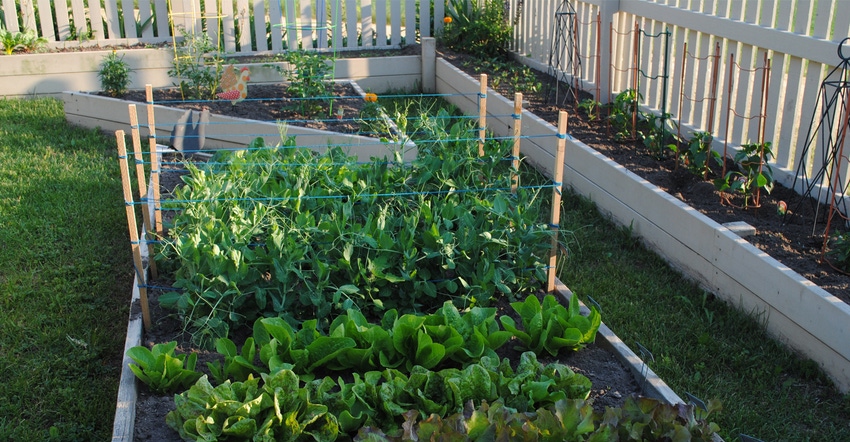March 11, 2022

With spring just around the corner, this is a great time to plan what vegetables you want to plant in your vegetable garden this year.
Some gardeners plant the same vegetables every year but change up how much they plant of each vegetable. Others like to try a few new vegetables. And then there are those who can’t make up their minds.
I always plant what vegetables I know we like to eat. It sounds simple, and it is, but why grow radishes and zucchini if nobody in your family eats them? Radishes and zucchini are easy to grow, but if nobody in your family likes them, then they are just taking up valuable space in your garden.
Not sure what vegetables to plant? Here is a list of 10 easy vegetables to grow:
Peas. They taste great cooked or picked by the handful and eaten raw. There are two main types: snap peas and snow peas. Depending on the variety you select, pea plants can grow 2 feet tall. They will need to be supported with some type of fence. I like to use chicken wire and plant a row of peas on each side of the fence. I plant each row about 2 inches from the fence. Plant the seeds in early spring, as peas prefer cool weather.
Potatoes. Here’s a fun fact: Did you know Americans eat about 114 pounds of potatoes each year? Potatoes are another cool-weather crop that do better planted in early spring. Purchase seed potatoes at a garden center and cut the potatoes into 2-inch wedges that each contain an eye. Plant the wedges 2 to 3 inches deep with the eye pointing up. They will be ready to start harvesting in July. I like to plant red potatoes, russets and Yukon golds. If you are only going to plant a few potatoes, it is better to select one variety.
Onions. This is another cool-weather plant that does better if planted in early spring. Purchase onion sets at your garden center. Plant onions 3 to 4 inches apart in a row. I plant yellow or white onions because those are the varieties my family prefers, and they are the most common at garden centers.
Broccoli. Broccoli plants are easy to grow and can be planted in early spring. Be sure to plant them in a row 18 inches apart. You can plant additional broccoli plants in June if your garden center still has plants, or you can plant broccoli seeds in a small container indoors and transplant the plants into your garden four weeks later.
Lettuce. I like to sow my lettuce seed in a large flowerpot on my deck. I usually grow a pot of black seeded Simpson lettuce and two weeks later, I sow a packet of mixed lettuce varieties in a second pot. That way I can harvest from one pot one week and switch to the second pot the next week. In August, I usually start over and seed more lettuce in two flowerpots.
Swiss chard. This is a very easy vegetable to grow in your garden. You can plant Swiss chard seeds or purchase seedlings at your local garden center. For some variety, select green, yellow and red varieties to add some color to your garden and your plate. It is a productive plant, making it one of the best choices for beginners. Swiss chard can be eaten raw in salads or cooked like spinach.
Carrots. This is another cool-weather crop that can be sown in early spring. You can grow several crops of carrots in one growing season. Just make sure you purchase extra seed in the spring when seeds are readily available at garden centers and hardware stores. It is important to thin a row of carrots to one carrot every inch or 2 after the carrot tops are a couple of inches high. Otherwise, you will end up with carrots that are crooked and small.
Green beans. These should be planted in mid-May after the threat of frost has passed. I prefer bush bean varieties because they produce a lot of beans and don’t need support. Make sure you pick beans two to three times a week when they are mature to prevent them from getting tough and too mature.
Tomatoes. Tomatoes are my favorite vegetable (fruit) and a favorite of most gardeners. I like to plant at least 10 tomato plants. I usually plant one cherry tomato and one yellow plum tomato to get lots of small tomatoes. I also plant a couple Early Girl tomatoes, which are usually the first to ripen in mid- to late July. I plant a couple of large varieties like Mortgage Lifter, which can produce tomatoes that weigh up to 1 pound each. I also select a couple of yellow tomatoes for variety and a few high-yielding, average-size tomatoes like Wisconsin 55, Better Boy or Celebrity. It’s important to wait until the threat of frost has passed before planting tomato plants in the garden. In southern Wisconsin, that is after Mother’s Day, but I have waited until Memorial Day weekend to plant them and had excellent results.
Bell peppers. Bell peppers, like tomatoes, should be planted after the threat of frost has passed in mid- to late May. These plants produce a lot of peppers from midsummer to midfall. Be sure to pick peppers as they mature.
Good planning will help you determine how much time and space you can dedicate to your garden. As a beginner gardener, start small. For your first plot, choose a sunny, well-drained area with good soil.
Comments? Email [email protected].
You May Also Like




